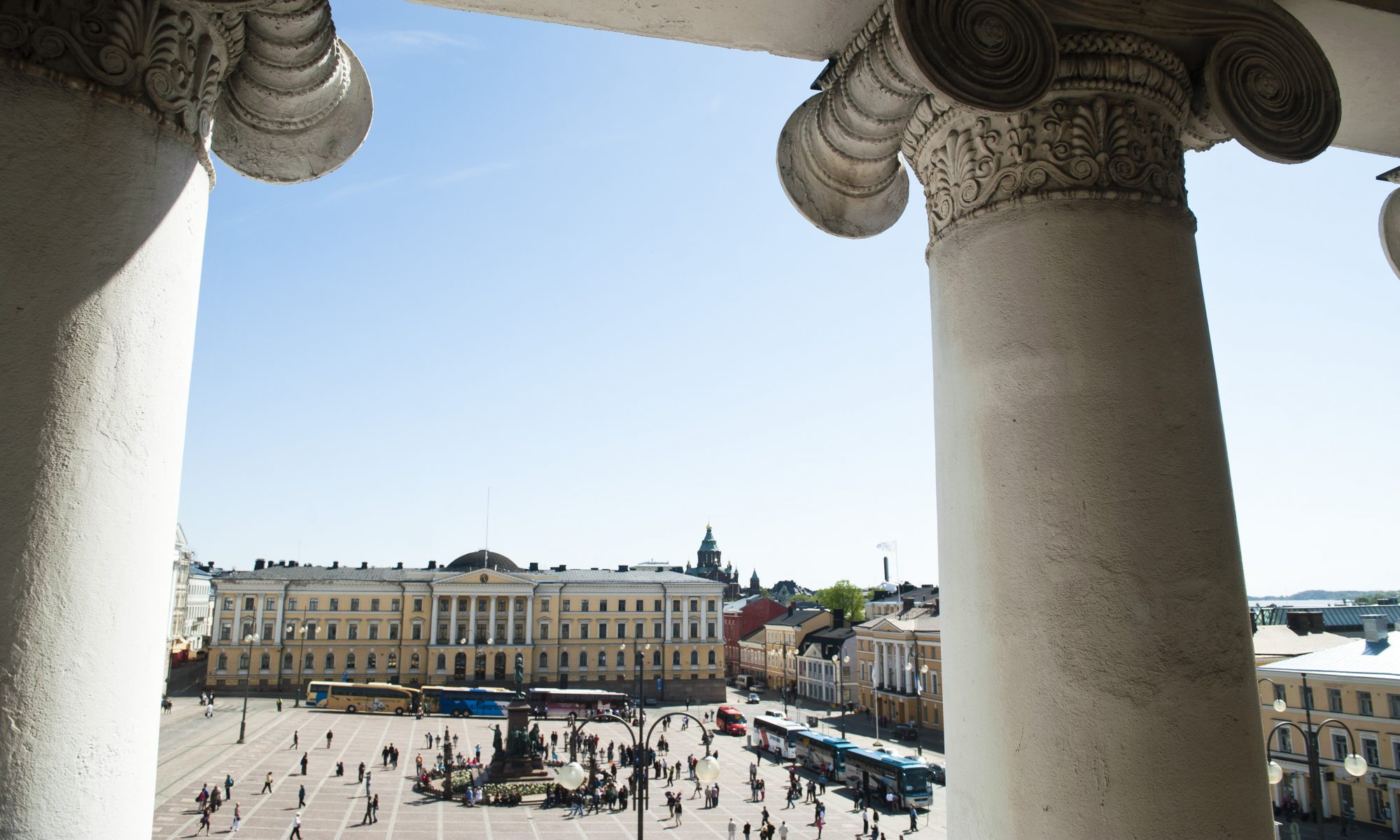”The vision is that EOSC (European Open Science Cloud) in ten years will be similar to the internet. It will be a virtual environment, where researchers can find and access data, and also services that can ease their work in research”, summarizes Sara Garavelli (CSC) EOSC’s goals in the near future. However, among researchers, EOSC is still not well known, as researcher Anca Hienola points out. In this interview, Garavelli and Hienola discuss EOSC from the perspective of researchers and research services. We also get an answer to the question, what is EOSC’s most tangible achievement at the moment.
Text: Juuso Ala-Kyyny & Mari Elisa Kuusniemi (Helsinki University Library)
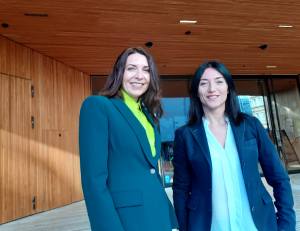
The European Open Science Cloud (EOSC) is a visionary plan to deliver a web of FAIR data and related services for researchers in Europe. In this article Sara Garavelli from CSC – IT Center for Science and Anca Hienola (ORCID) from the Finnish Meteorological Institute (FMI) discuss EOSC.
Sara Garavelli is responsible for EOSC programme at the CSC, and she is also one of the directors at the board of EOSC Association. At national level she is coordinating the EOSC Finnish Forum. Anca Hienola, a senior researcher at the FMI, is a climate scientist by training, but several years ago she ”started her journey” in open science and EOSC. At the moment, she works in three EOSC related projects – in EOSC Nordic, co-coordinating ENVRI-FAIR, as a task leader in EOSC Future.
This article is part of the Think Open blog’s dialogue interview series, where the interviewees themselves have chosen the themes and questions they discuss. In this dialogue interview, the following questions are discussed:
- What is EOSC?
- Are researchers aware of EOSC?
- What EOSC has developed so far?
- What is EOSC offering to researchers that they don’t have now?
- How Finnish researchers can find out more about and get engaged in EOSC?
In addition to these questions, themes related to EOSC membership, University of Helsinki’s connections to EOSC, current issues in EOSC and Digital Competence Centres are discussed at the end of the interview.
What is EOSC?
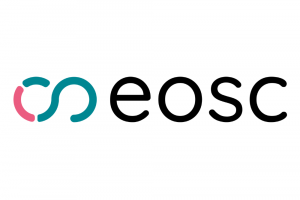 Sara Garavelli: ”From the EOSC Association’s perspective, EOSC is a web of FAIR data and related services for research. But what does this mean in reality? The vision is that EOSC in ten years will be similar to the internet. It will be a virtual environment, where researchers can find and access data, and also services that can ease their work in research. So, EOSC aims to become the enabling tool for open science.”
Sara Garavelli: ”From the EOSC Association’s perspective, EOSC is a web of FAIR data and related services for research. But what does this mean in reality? The vision is that EOSC in ten years will be similar to the internet. It will be a virtual environment, where researchers can find and access data, and also services that can ease their work in research. So, EOSC aims to become the enabling tool for open science.”
Anca Hienola: ”I think pretty much the same. EOSC will bring a new way of making science for researchers. It is indeed a tool, as you said – very complicated to build, and hopefully very easy to use. So, researchers will have possibility to search and find data with related services and everything they need for their scientific journey.”
Are researchers aware of EOSC?
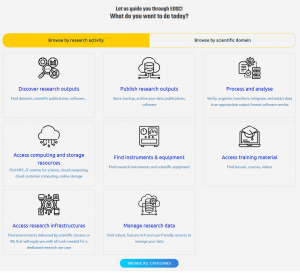
AH: ”Oh, this is going to be a fight! No, they don’t. One idea is that researchers should not know about EOSC, and I think you, Sara, will come to that later. But I think researchers should know at least one EOSC product, that is the EOSC portal, because it is a gateway to services and to other fields of sciences in case they want to have interdisciplinary projects.”
SG: ”I agree with you, a lot of work need still to be done to increase awareness about the EOSC among researchers and also in the organisations supporting researchers. But what you said, in the end, do researchers need to know about the EOSC? We believe that probably not. You don’t need to know internet protocols to use the internet. In ten years, it will be the same with the EOSC. But of course, at this initial phase it is really important, that everyone understands the vision where do we want to go.”
AH: ”This is a tool we are building for researchers. If they are not involved, the tool will be good for nothing. But I think this has changed drastically with the EOSC Future project. In the EOSC Future we have a pool of several hundreds of researchers from Europe, from different fields of science and from different levels seniority. And they have been consulted from different aspects of EOSC. It is extremely good thing that their voice is heard now.”
SG: ”Yes, but I think there is difference between co-design and adoption. In co-design, we need to involve sensible amount of researchers to make sure that we’ll take into account their needs. But when it comes to adoption, broadening the knowledge about a specific tool, we need also to wait for the right time, so that it really offers added value for researchers. Otherwise we lose them too early.”
AH: ”And they’ll never come back.”
SG: ”Yes.”
I think researchers should know at least one EOSC product, that is the EOSC portal.
What EOSC has developed so far?
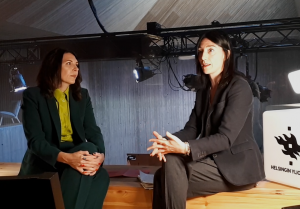 SG: ”EOSC has been launched in 2016 with the communication of the European Commission (EC). Since then a series of EC funded projects have been funded for its implementation. Only in 2021 a governance has been established. Why is this important? Now there are two parties, the EC and EOSC Association – which is a legal entity composed of around 200 organisations representing the voice of the community – that are committed to the implementation of EOSC, also in terms of funding. These two parties are also working in strong collaboration with the representatives of the member states and associated countries bringing into EOSC the perspectives and the support of the countries. Having a governing instrument to support the implementation of EOSC, is a big step forward.”
SG: ”EOSC has been launched in 2016 with the communication of the European Commission (EC). Since then a series of EC funded projects have been funded for its implementation. Only in 2021 a governance has been established. Why is this important? Now there are two parties, the EC and EOSC Association – which is a legal entity composed of around 200 organisations representing the voice of the community – that are committed to the implementation of EOSC, also in terms of funding. These two parties are also working in strong collaboration with the representatives of the member states and associated countries bringing into EOSC the perspectives and the support of the countries. Having a governing instrument to support the implementation of EOSC, is a big step forward.”
AH: ”I think this (governance) is very important, at least from a sustainability point of view. But I am afraid that a regular researcher doesn’t care about these things. So, I don’t know if EOSC at this moment has achieved something which is really visible, palpable for a researcher. Not yet. We are building blocks, and at certain moment we’ll put them together. And then it will be real value for researchers.”
SG: ”I agree that main added value of the governance is really for ensuring the sustainability. Because that is the most common question we receive: ’What’s happening if I start using a tool maybe resulting from a project after the end of the project?’ So far it has been difficult to give an answer to that question, but through the governance we’ll hope we can build more long-term perspective.”
AH: For me, it is now a little bit clearer where we want to go and what we want to achieve. If we talk about tangible things, EOSC portal is the only tangible product for researchers I can think of at the moment.”
SG: ”And the efforts related to the EOSC portal have come from the EOSC Future, which was the first project where the infrastructures were working together with the research infrastructures. This was also a big achievement that these actors, who have historically worked in silos, started to work together.”
The most common question we receive: ’What’s happening if I start using a tool maybe resulting from a project after the end of the project?’
What is EOSC offering to researchers that they don’t have now?
 SG: ”EOSC will offer a new way of doing science. Recently, there was an event in Tallinn where EC presented results of a study, European Research Data Landscape. There were a couple of numbers that captured my attention. 60 percent of researchers store their data on their local physical storage. That’s something EOSC wants to change, because this means that the data won’t be re-accessible or re-usable in the future – and we know that the data will be the new gold. According to the study, only one third of researchers have heard about FAIR. That’s also a big challenge for EOSC and the entire open science movement.”
SG: ”EOSC will offer a new way of doing science. Recently, there was an event in Tallinn where EC presented results of a study, European Research Data Landscape. There were a couple of numbers that captured my attention. 60 percent of researchers store their data on their local physical storage. That’s something EOSC wants to change, because this means that the data won’t be re-accessible or re-usable in the future – and we know that the data will be the new gold. According to the study, only one third of researchers have heard about FAIR. That’s also a big challenge for EOSC and the entire open science movement.”
AH: ”At the beginning of the EOSC Future project, we asked researchers about their pain points. Finding data was one of the problems, followed by the availability of repositories for publishing or just storing data. In cross-border projects, members were using tools that were not compatible. So, imagine now that the EOSC will become that amazing environment, where you’ll find the data you need without going through hundreds of repositories, you’ll find the storage for your FAIR data with rich metadata, you will get computing resources when needed, you’ll have access and links to all research infrastructures with their data and services, you will have access to training, and you will also have a project platform where all the members – no matter where they come from – can use compatible services. I think EOSC should try to alleviate these pain points to make researchers lives easier.”
SG: ”I would add that EOSC is also about people. All the competencies and skills that we are creating are making the difference. The tools alone are not enough, I think we need also a workforce working in the same direction with the same principles.”
I think EOSC should try to alleviate these pain points to make researchers lives easier.
How Finnish researchers can find out more about and get engaged in EOSC?
 SG: ”There are many ways, because EOSC doesn’t act only pan-European level but also in national and institutional levels. In Finland, we have started an initiative called the EOSC Finnish Forum. We decided to organize this forum to make sure that all individuals in Finland that have signed the Declaration of Open Science have an arena where they can find more information about EOSC but also exchange information about what they are doing on open science, FAIR and so on. And why is this important? Through the EOSC Finnish Forum we can bring our national views in European context, and vice versa. We are organizing webinars, we have open calls for participating in open science or FAIR related initiatives. So, I think the EOSC Finnish Forum is an easy way to start being connected with the EOSC. At the same time, it is important that each organization is aware of what EOSC is about and what it wants to achieve as it is very clear that open science activities needs institutional support.”
SG: ”There are many ways, because EOSC doesn’t act only pan-European level but also in national and institutional levels. In Finland, we have started an initiative called the EOSC Finnish Forum. We decided to organize this forum to make sure that all individuals in Finland that have signed the Declaration of Open Science have an arena where they can find more information about EOSC but also exchange information about what they are doing on open science, FAIR and so on. And why is this important? Through the EOSC Finnish Forum we can bring our national views in European context, and vice versa. We are organizing webinars, we have open calls for participating in open science or FAIR related initiatives. So, I think the EOSC Finnish Forum is an easy way to start being connected with the EOSC. At the same time, it is important that each organization is aware of what EOSC is about and what it wants to achieve as it is very clear that open science activities needs institutional support.”
AH: ”I would advertise the EOSC portal. We are still revamping it, and it will become a very logical and user-friendly website. And of course, if you start to use EOSC services, give feedback. That is how we evolve and make things better in the future.”
SG: ”Finally, I would add that we can also bring our national level expertise to Europe. EOSC Association has organized task forces on specific topics, and these task forces are good instruments to provide our expertise into Europe. In Finland we have a big number of EOSC ambassadors: all the people that are working in EC-funded projects. We have also research infrastructures at the national level like ELIXIR, ICOS and Actris – all these initiatives are a good way to connect to EOSC. So, if you are not a part of EOSC related project with EOSC on the name, it doesn’t mean that you are not connected to EOSC.”

Open session
At this point, the interview shifts to an open session with Mari Elisa Kuusniemi and Juuso Ala-Kyyny from the Helsinki University Library and Data Support network at the UH.
Members of EOSC?
MEK: ”Who are the members of EOSC, individuals or organisations, or both?”
SG: ”In the EOSC Finnish Forum, we are talking about individuals who have signed – or whose organisations have signed – the Declaration of Open Science. When it comes to EOSC Association, you need to have a legal entity, so it’s an organizational level. In Finland, there is only one member, CSC, but we hope that in the future there will be more. If we look at our cousins in Sweden, they have number of universities and they have organized a forum where they discuss regularly about EOSC plans.”
AH: ”FMI is also considering to become at least observer of EOSC, and maybe later a full member.”
What can University of Helsinki do?
JA: ”I have a question from Ville Tenhunen from the IT Center at the UH: ’What the University of Helsinki should do with the EOSC? How we can help the EOSC to achieve its goals?'”
SG: ”As far as I know, the University of Helsinki is already active at national level in the context of the EOSC Finnish Forum. From the EOSC Association’s perspective, we are really looking for use cases and best practices related to open science and FAIR. So, if the UH develops a service, a tool or a best practice that could be relevant also to other researchers, the best thing to do is to make others aware of it. That is an effective way to contribute on EOSC. Also, I would really like to see the UH as a member of EOSC Association.”
AH: ”UH is already involved in several EOSC related projects, for example the one I am co-coordinating, that is ENVRI-FAIR.”
SG: ”UH is also a partner in a new project called FAIRCORE4EOSC.”
AH: ”And of course, UH can try to make their researchers aware of EOSC.”
MEK: ”Or FAIR?”
AH: ”Absolutely.”
SG: ”UH is also hosting OpenAIRE NOAD (National Open Access Desks). These national contact points are important for creating awareness.”
Hot topics of EOSC?
JA: ”What are the hot topics of EOSC in the near future?”
SG: ”From EOSC Association’s perspective, our hot topic this year is to start thinking what happens in EOSC after 2027. We really look at things in the long term. So, who’s gonna pay for EOSC – EC, member states, organisations? EOSC Association’s priority is to look at the future, and make sure we have solid financial sustainability for EOSC and we identify the right priorities to make sure we have concrete results also from the implementation perspective.”
AH: ”For me, a hot topic is this: Is EOSC good enough for researchers to start using it? Because without users, EOSC doesn’t exist.”
JA: ”By the way, what has motivated you to join EOSC as a researcher, Anca?”
AH: ”Frustration. I was doing my research, and I wrote a very good paper, which was cited in IPCC report. I was not able to publish it, because I had three terabytes of data, and I didn’t know what to do with that much data. So, I started looking at the matters of open science. And this is how I got involved. As I said before, if we succeed to alleviate the pains of researchers wherever they are, it will be a great success.”
About Digital Competence Centres
MEK: ”We have quite a big Data Support service at the UH with lawyers and experts from the IT Center and the library. I have heard of Digital Competence Centres (DCC), and the UH Data Support can also be seen as a kind of DCC – it provides training, websites, consulting agreements and DMPs etc. But is there a role with DCCs in EOSC?”
SG: ”I think this is one of the key functions we need to succeed. There is still lack of skills and competencies, so the support is fundamental. Skills4EOSC, launched in September, brings together around 40 partners from Europe, and one of its purposes is to build a concept of ’national competence centres’. But these do not need to be built from scratch. Rather, it’s about understanding what is being done in different countries, and leverage on existing resources in a better coordinated and structured way.”
AH: ”There is a category in EOSC called ’Training’. I think the UH has very high standards for training packages, and it could be a very good idea to get your services onboard. That way, other researchers in Europe can take advantage of your knowledge.”

Articles previously published in the series of dialogue interviews:
- Mikrobeista maailmaan muuttamiseen – Kaarina Sivonen ja Anssi Mälkki keskustelevat tutkimuksen arvioinnista (19.3.2020)
- How to promote openness? Paula Eerola and Tuuli Toivonen discuss scientific publishing and research data (16.11.2018)
- The battle over data has begun – Jouko Väänänen and Mikko Tolonen discuss digitalisation and open science (7.5.2018)
